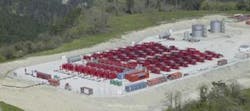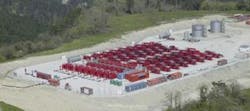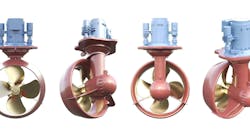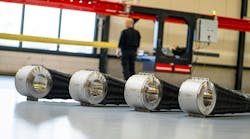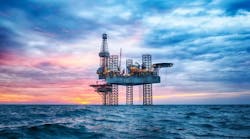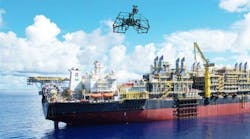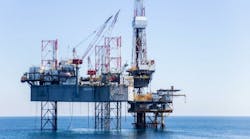Eldon Ball
Managing Editor
When Weatherford Pipeline and Specialty Services accepted the contract to perform the dewatering and drying operation for the Bluestream pipeline, the world's deepest offshore natural gas pipeline system, the company expected some challenges. Even so, the project for the dual 385-km, 24-in. lines under the Black Sea from Russia to Turkey presented a combination of technological, political, logistical, and environ- mental hurdles that far exceeded expec-tations.
Technologically, the operation involved line pressures of up to 250 bar, a length of 385 km, water depth of 2,150 m (7,053 ft), and ambient temperatures onshore of -15° F in the winter to 105° F in the summer.
Logistically, it called for moving 150 shipboard containers of equipment, supplies, and tools to a remote location on the shores of the Black Sea, installing 70 compressors, locating supplies of about 50,000 gal/day of diesel fuel, and finding housing for a staff of about 50 to 70 personnel.
Politically, the team had to secure a "passport" for every piece of equipment that entered the country – a bureaucratic feat that involved providing design and operating specifications and explanations of how the equipment worked.
Environmentally, the weather provided it's own set of challenges, including a 50-year ice storm, hurricane force winds, and a subsequent flood that devastated the local countryside.
"It was a huge undertaking," said Troy Dilzell, manager of the Bluestream project for Weatherford. "The equipment is the same that we run every day, but to put it all together, it's the first time it's ever been done in the world. That was the uniqueness of it – all the elements coming together and all of it working. We were fortunate that we had a good team of people and we had a lot of support from Weatherford. That is what made the project an overwhelming success and the largest mobile compression station ever assembled in the world."
Operations
Weatherford's role was two-fold. During the pipelay operations – performed by the customer's J lay barge – they were on stand-by in case the pipeline flooded during the pipelay process – a situation known as a "wet buckle" in which water floods the line as it is being laid. If that occurred, it would be Weatherford's job to clear the line of water.
"The potential for a wet buckle is there in any pipelaying operation," Dilzell said, "but it was even more the case in this project, because of the depth of the water and the length of the line. If it were to happen, they would shut down operations, send an ROV down, cut the pipe, install a valve, and we'd be on hand to blow the water out of the pipe so they can lift it back up and start again."
The main purpose of the station is to de-water and dry the line before gas is allowed to pass through it. It's a critical step in the commissioning of the line. If not done properly, the potential for hydrate formation, and a blockage of the line, increases significantly.
Once the line is in place on the seabed, it's flooded to allow for hydrostatic pressure testing. The line is tested to 1.5 times its operating pressure to test for leaks, valve integrity, or poor welds.
"After the line is pressure tested, we start the station and launch de-watering pigs, which pushes all the water out from Russia to Turkey," Dilzell said.
Because of the unusual operating parameters of the project, Weatherford used dry air in the de-watering operation to start the drying process in advance of the actual drying operations.
"Because it took so long to fill the volume of the pipeline from Russia to Turkey with dry air, the customer decided to de-water with dry air. This allowed for one full volume of dry in the pipeline, before drying began" Dilzell said. "Once we sweep the water out in the de-watering phase, then we depressurize the line, because we have to begin the drying phase at a low pressure. Then we run a portion of the station, depending on the drying speed, and we pump dry, oil-free, -80° C air into the pipeline. This removes the balance of the moisture from the line."
The project included an on-site programmable logic controller (PLC) in a main station control room and unit PLCs on individual operating equipment to monitor and provide real-time data on engine parameters, injection line temperatures, flow, and pressures.
"It was critical that we have no downtime during the operation," Dilzell said, "so every piece of equipment was tied into data collection system. This allowed the operations manager and the control technicians to identify problems quickly and virtually eliminate critical problems. Everyone on location was required to wear integrated headsets that were monitored by the control room. If there was a problem, we could radio out and say, for example, that Unit 36 is overheating on the booster, so shut it down. We had no unscheduled downtime due to equipment failure."
null
Bureaucratic hurdles
Politically, the job required hundreds of special permits for operating in Russia, including a passport for each piece of equipment.
"Under Russian law, everything that is imported into the country is required to have a third party certificate," Dilzell said. "Every-thing on location had to have a permit – along with operating permits, an air discharge permit, a water discharge permit, a land preparation permit. We had to provide all of the design and engineering drawings for the entire station and explain how it was designed as well as how it works, to the third party certifier. Then, we were issued a passport that details the equipment's operation and gives the specifications in Russian. You can't operate without the technical passports."
Dilzell said the language barrier was not as much a problem as was the technology barrier, because Russian technology lags behind US technology in a number of areas.
"The first time I explained how our compressors worked to a group of Russian engineers, they shook their heads and said it wasn't possible," Dilzell said. "They couldn't believe that piece of equipment would do the same thing that the Russians do with a much more massive piece of equipment."
The Weatherford team also had to go through training in the Russian way of doing things, Dilzell said. Russian specialists taught weeklong courses for operating pressure vessels and industrial safety.
Logistics
To provide the compressor capacity needed for the project, Weatherford built a completely self-contained operating station with 70 combination compressor units requiring 55,000 gal of fuel a day at full operating capacity. Each 755-hp unit was capable of delivering 1,100 standard cubic feet per minute (scfm) at 2,000 psig. This provided a combined horsepower on location of 52,850 hp.
Just getting the equipment moved into place and establishing a working station proved to be a challenge of its own. It required specially built compressors, creative purchasing to find the right kind of fuel, and food – a major issue for a remote location. "Moving the equipment into place required 150 shipboard containers," Dilzell said. "The compressors themselves were built just like a 20-foot sea container, exactly the same dimensions, so they could be stacked on the vessel. We changed our standard design, squeezed it down a little bit, so it could fit on a vessel perfectly."
Because Weatherford was under a no-downtime contract, the team had to have total redundancy, at least one replacement for every major piece of equipment on location.
"If anything broke down, we had to be able to fix it immediately," Dilzell said. "So, we had about 15 40-foot containers for spare parts, oil filters, tools, you name it. Every single component had to go through customs, and sometimes the Russians didn't understand what they were looking at or what it was used for."
Buying diesel fuel locally was an even bigger issue, Dilzell said, both in terms of quantity and quality.
"The fuel was bought locally, but the issue with the fuel was securing that much from Russia during their peak season. The other issue was that we spent a lot of time working with the refineries to make sure they had the proper fuel quality. We were running very sophisticated electronic engines that met all the air standards for the United States and finding the proper fuel supply was a challenge."
Even after requesting a higher grade of diesel, Weatherford filtered it a total of seven times before it got to the engines.
"We went through thousands of filters just to keep the equipment running properly. We filtered it as we were loading it into the tanks; we filtered it after it went through our pumping system, and we filtered it three times on the equipment before it even got to the engine. Then, there was the problem with fluid gelling, because diesel fuel gels as it gets cold. We brought our own additives from the United States to prevent gelling. The negotiations we had to go through to secure that much fuel was unbelievable."
"The design of the compressors was key to Weatherford being chosen for the project," Dilzell said. "Weatherford is the only company in the world that has this type of design. A single-drive engine drives both a two-stage helical screw compressor and a horizontal reciprocating compressor. For a standard application of compressors, our competitors would have to use three pieces of equipment to do what ours will do with one. We could do a much smaller footprint of equipment."
The compressors fed into a drier system that was again designed specifically for this project, Dilzell explained. The air had to be at a -60° C dew point at the injection point. The compressed air then goes from the drier into boosters that increase the pressure from about 1,700-lb to 4,000-lb pressure.
Weather challenges
The greatest challenges of all may have come in the form of unpredictable weather conditions, including an ice storm with hurricane force winds and a flood.
"We had a fifty-year ice storm with winds so bad that it wiped out about 20% of the local timber," Dilzell said. "It looked like a hurricane or tornado had come through – trees were splintered in half. They shut down the entire region for about three weeks. It toppled all their power lines; those big metal power lines just crumpled over, and the local town lost all their power. Weatherford had its own generators on location, so power was not an issue, but we were chipping ice off equipment for days."
Then, the ice storm was followed quickly by a flood as the ice melted.
"The ice melted and then the region was socked by a huge rainstorm, which unfortunately washed many local campers into the Black Sea. It washed out all the roads and we couldn't get to our location."
The flood in Russia had been foreshadowed by a similar situation in Houston when the project was preparing to launch. The Weatherford team had built a one-quarter-scale demonstration station near the Houston ship channel to do a test before mobilizing to Russia. Hurricane Allison, which produced one of Houston's more memorable floods, started moving in just as the plant began testing.
"We were afraid everything was going to wash into the ocean. We were fortunate, because we were the highest point on the Houston port, and water got just up to the edge of our skids. If the water had gotten much higher, it would have filled all the engines and we would have been shut down. Then we got over to Russia, and we had ice and another flood and I said, 'You know, all we need now is some locusts to come through and eat all of our hydraulic lines.' Plus, we were in a real high earthquake environment. We had to design a station for 8.5 on the Richter scale, because it's right on the fault that runs from Turkey to Russia."
Future projects
The equipment for the Bluestream project has been designed as a high-volume/high-pressure compressor station able to operate anywhere in the world. Several projects in the design and engineering phase will require a station of this magnitude. Weatherford is positioned to answer the call of any customer requiring such a station and service, Dilzell says.
"Weatherford didn't do this for just this project," Dilzell said. "The equipment that we used for Bluestream is the same equipment that we use all over the world. So, regardless of whether any other projects were to develop after this, we could still use the equipment. At the same time, there were six projects on the table globally that required stations this size or larger. Then there's one that goes from Oman to India in 10,600 feet of water, so it's going to require an even bigger station. As a matter of fact, we're already talking to engineering and manufacturing, because we have to build equipment that's never been built before to take more volume and higher pressures."
